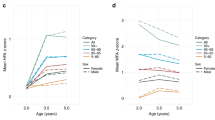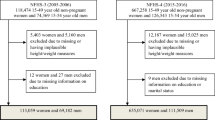Abstract
Background:
Research on the shift in children's body mass index (BMI) distribution is limited and conditional mean models used in the previous research have limitations in capturing cross-distribution variations in effects. The objectives are to analyze the shift in Chinese children’s BMI distribution and to test the associations between BMI distribution and other factors.
Methods:
We analyzed data collected from children 7 to 17 years old from the China Health and Nutrition Survey (CHNS) conducted in 1997, 2000, 2004, 2006, 2009 and 2011, from 2814 participants with 6799 observations. Longitudinal quantile regression (QR) was used to explore the effect of several factors on BMI trends in 2015.
Results:
The BMI curves shift to the right in boys and girls, with the distributions becoming wider, indicating a higher proportion of children have become overweight. The 5th, 15th, 50th, 85th and 95th BMI percentile curves all shifted upward from 1997 to 2011, and the higher percentiles had greater increases. The prevalence of overweight and obesity increased in boys and girls between 1997 and 2011, from 6.5 to 15.5% in boys and from 4.6 to 10.4% in girls. Energy intake and parents’ BMI levels had a positive association with children’s BMI. Per capita income was positively associated with changes in BMI only at the upper percentiles of the BMI distributions in boys. Increased physical activity (PA) was associated with decreased BMI in girls.
Conclusions:
Children in China are becoming increasingly overweight. Energy intake, parental BMI, PA and early menarche age in girls are associated with elevated BMI in children.
This is a preview of subscription content, access via your institution
Access options
Subscribe to this journal
Receive 12 print issues and online access
$259.00 per year
only $21.58 per issue
Buy this article
- Purchase on Springer Link
- Instant access to full article PDF
Prices may be subject to local taxes which are calculated during checkout


Similar content being viewed by others
References
Popkin BM, Adair LS, Ng SW . Global nutrition transition and the pandemic of obesity in developing countries. Nutr Rev 2012; 70: 3–21.
Wang Y, Mi J, Shan XY, Wang QJ, Ge KY . Is China facing an obesity epidemic and the consequences? The trends in obesity and chronic disease in China. Int J Obes (Lond) 2007; 31: 177–188.
Singh AS, Mulder C, Twisk JW, van Mechelen W, Chinapaw MJ . Tracking of childhood overweight into adulthood: a systematic review of the literature. Obes Rev 2008; 9: 474–488.
Li Y, Yang X, Zhai F, Piao J, Zhao W, Zhang J et al. Childhood obesity and its health consequence in China. Obes Rev 2008; 9 (Suppl 1): 82–86.
Ji CY, Chen TJ, Sun X . Secular changes on the distribution of body mass index among Chinese children and adolescents, 1985-2010. Biomed Environ Sci 2013; 26: 520–530.
Wang H, Du S, Zhai F, Popkin BM . Trends in the distribution of body mass index among Chinese adults, aged 20-45 years (1989-2000). Int J Obes (Lond) 2007; 31: 272–278.
Yin G, Cai J . Quantile regression models with multivariate failure time data. Biometrics 2005; 61: 151–161.
Geraci M, Bottai M . Quantile regression for longitudinal data using the asymmetric Laplace distribution. Biostatistics 2007; 8: 140–154.
Popkin BM, Du S, Zhai F, Zhang B . Cohort profile: the China Health and Nutrition Survey–monitoring and understanding socio-economic and health change in China, 1989-2011. Int J Epidemiol 2010; 39: 1435–1440.
Zhang B, Wang HJ, Du WW . [Progress of cohort study and its inspiration to China Health and Nutrition Survey]. Zhonghua Yu Fang Yi Xue Za Zhi 2011; 45: 295–298.
Du S, Mroz TA, Zhai F, Popkin BM . Rapid income growth adversely affects diet quality in China—particularly for the poor!. Soc Sci Med 2004; 59: 1505–1515.
Popkin BM . The nutrition transition: an overview of world patterns of change. Nutr Rev 2004; 62 (7 Pt 2): S140–S143.
Cui Z, Dibley MJ . Trends in dietary energy, fat, carbohydrate and protein intake in Chinese children and adolescents from 1991 to 2009. Br J Nutr 2012; 108: 1292–1299.
Monda KL, Gordon-Larsen P, Stevens J, Popkin BM . China's transition: the effect of rapid urbanization on adult occupational physical activity. Soc Sci Med 2007; 64: 858–870.
Cole TJ, Green PJ . Smoothing reference centile curves: the LMS method and penalized likelihood. Stat Med 1992; 11: 1305–1319.
Cole TJ, Bellizzi MC, Flegal KM, Dietz WH . Establishing a standard definition for child overweight and obesity worldwide: international survey. BMJ 2000; 320: 1240–1243.
Ogden CL, Carroll MD, Kit BK, Flegal KM . Prevalence of obesity and trends in body mass index among US children and adolescents, 1999-2010. JAMA 2012; 307: 483–490.
Kromeyer-Hauschild K, Zellner K . Trends in overweight and obesity and changes in the distribution of body mass index in schoolchildren of Jena, East Germany. Eur J Clin Nutr 2007; 61: 404–411.
Wang Y, Lobstein T . Worldwide trends in childhood overweight and obesity. Int J Pediatr Obes 2006; 1: 11–25.
Wang Y, Lim H, Wu Y . Growing global burden of chronic noncommunicable diseases and an alarming situation in China. Beijing Da Xue Xue Bao 2012; 44: 688–693.
Cao ZQ, Zhu L, Zhang T, Wu L, Wang Y . Blood pressure and obesity among adolescents: a school-based population study in China. Am J Hypertens 2012; 25: 576–582.
Lu X, Shi P, Luo CY, Zhou YF, Yu HT, Guo CY et al. Prevalence of hypertension in overweight and obese children from a large school-based population in Shanghai, China. BMC Public Health 2013; 13: 24.
Chen S, Binns CW, Zhang Y . The importance of definition in diagnosing obesity: a review of studies of children in China. Asia Pac J Public Health 2012; 24: 248–262.
Li YP, Hu XQ, Jing Z, Yang XG, Ma GS . Application of the WHO growth reference (2007) to assess the nutritional status of children in China. Biomed Environ Sci 2009; 22: 130–135.
Xu YQ, Ji CY . Report on childhood obesity in China (7). Comparison of NCHS and WGOC. Biomed Environ Sci 2008; 21: 271–279.
Ogden CL, Carroll MD, Flegal KM . High body mass index for age among US children and adolescents, 2003-2006. JAMA 2008; 299: 2401–2405.
Classen TJ . Measures of the intergenerational transmission of body mass index between mothers and their children in the United States, 1981-2004. Eco Hum Biol 2010; 8: 30–43.
Zhang QLR, Chen HJ, Xue H, Wang Y . Does child-parent resemblance in body weight status vary by socio-demographic factors in the United States? J Epidemiol Commun Health 2014; 68: 1034–1042.
te Velde SJ, van Nassau F, Uijtdewilligen L, van Stralen MM, Cardon G, De Craemer M et al. Energy balance-related behaviours associated with overweight and obesity in preschool children: a systematic review of prospective studies. Obes Rev 2012; 13 (Suppl 1): 56–74.
Hodgkin E, Hamlin MJ, Ross JJ, Peters F . Obesity, energy intake and physical activity in rural and urban New Zealand children. Rural Remote Health 2010; 10: 1336.
Mitchell JA, Rodriguez D, Schmitz KH, Audrain-McGovern J . Greater screen time is associated with adolescent obesity: a longitudinal study of the BMI distribution from Ages 14 to 18. Obesity (Silver Spring) 2013; 21: 572–575.
Yang TC, Matthews SA, Chen VY . Stochastic variability in stress, sleep duration, and sleep quality across the distribution of body mass index: insights from quantile regression. Int J Behav Med 2013; 21: 282–291.
Chen CM, Chang CK, Yeh CY . A quantile regression approach to re-investigate the relationship between sleep duration and body mass index in Taiwan. Int J Public Health 2012; 57: 485–493.
Li YP, Hu XQ, Schouten EG, Liu AL, Du SM, Li LZ et al. Report on childhood obesity in China (8): effects and sustainability of physical activity intervention on body composition of Chinese youth. Biomed Environ Sci 2010; 23: 180–187.
Acknowledgements
The research was supported in part by a research grant from the US National Institutes of Health (NIH, grant no.1U54hd070725), the Eunice Kennedy Shriver National Institute of Child Health and Human Development, and Office of Behavioral and Social Sciences Research. It is part of the collaboration project between the National Institute of Nutrition and Food Safety at the Chinese Center for Disease Control and Prevention and the University at Buffalo, State University of New York. The content of the paper is solely the responsibility of the authors and does not necessarily represent the official views of the funders. This research uses data from the CHNS. We thank the National Institute for Nutrition and Food Safety at the Chinese Center for Disease Control and Prevention, the Carolina Population Center at the University of North Carolina at Chapel Hill, and the US NIH (R01-HD30880, DK056350, R24 HD050924, and R01-HD38700) for financial support for the CHNS data collection and management.
Author contributions
HW and BZ contributed to the initial design of the analysis. HW and JZ contributed to the analysis. All authors contributed to the interpretation of data analysis results. HW wrote the first draft of the manuscript. HX, SD and YW revised the manuscript. YW led the effort receiving the NIH grant (1U54hd070725) that funded the international collaboration project and has provided some administrative support for developing the manuscript.
Author information
Authors and Affiliations
Corresponding author
Ethics declarations
Competing interests
The authors declare no conflict of interest.
Rights and permissions
About this article
Cite this article
Wang, H., Xue, H., Du, S. et al. Time trends and factors in body mass index and obesity among children in China: 1997–2011. Int J Obes 41, 964–970 (2017). https://doi.org/10.1038/ijo.2017.53
Received:
Revised:
Accepted:
Published:
Issue Date:
DOI: https://doi.org/10.1038/ijo.2017.53
This article is cited by
-
Spatiotemporal predictions of obesity prevalence in Chinese children and adolescents: based on analyses of obesogenic environmental variability and Bayesian model
International Journal of Obesity (2019)
-
Associations of physical activity and fruit and vegetable intake with well-being and depressive symptoms among obese schoolchildren in Wuhan, China: a cross-sectional study
BMC Public Health (2018)



